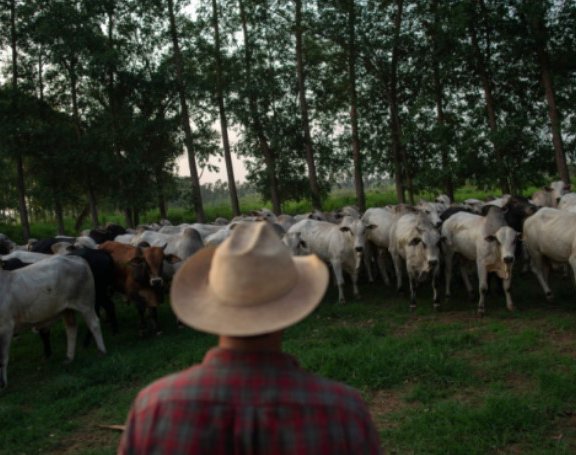Fashion brands have a new problem: committing to sourcing leather from verified "deforestation-free" supply chains by 2030, if not sooner. In this Sourcing Journal report, as Textile Exchange and the Leather Working Group (LWG) launched this challenge on Thursday 17/11 at the 2022 Conference in Colorado Springs. [Textile Exchange Wants Fashion to Take a Second Look at ... – SJ]
“Stopping deforestation is one of the most important things we can do as an industry,” said Anne Gillespie, director of impact acceleration at Textile Exchange, a nonprofit dedicated to the proliferation of preferred fibers. Trees play an essential in fighting global warming, scientists say. Protecting and restoring forests would help the world achieve 18 percent of the emissions mitigation needed by 2030 to avoid catastrophic climate change.
Gillespie said she knows this won’t be easy. Leather supply chains are among the longest and most opaque, she said.
“We can’t just say to brands, ‘O.K., you have to stop sourcing from deforestation sources,’” Gillespie said. “It’s a direction of travel that gets us to that final destination by 2030.”
Besides the LWG, Textile Exchange is working with the National Wildlife Federation, World Wildlife Fund and Accountability Framework to develop “alignment, definitions, targets, [and] tools” to help everyone get there. Everything, however, starts with a pledge, and then a policy to be deforestation-free. From there, companies can evaluate their supply chains.
Most brands, she added, don’t know where their leather comes from.
Indeed, more than 30 percent of the fashion sector’s tentpole firms have “some kind” of deforestation policy in place, yet clear-cutting in the Brazilian Amazon has continued to rise over the last decade, according to Stand.earth, an environmental nonprofit that together with advocacy group Slow Factory pored through international customs data in December to uncover myriad murky supply-chain connections between leather and vanishing ecosystems.
They found links between some of the world’s biggest names—Adidas, Coach, Gap, H&M, Keen, LVMH Moët Hennessy, Prada, Ralph Lauren, Timberland owner VF Corp., Ugg and Zara, among them—to manufacturers and tanneries with known links to cattle raised on recently deforested Amazon land. H&M admitted at the time that the “low transparency” the whole industry faces means that some level of risk will always be present.
Overall, it said, fashion continues to “drive” deforestation.
Gillespie said that LWG has tools to help brands identify regions of risk, down to the slaughterhouse level. But fashion purveyors also need to start investing in deforestation-free cattle farms by using impact incentives as a leverage tool.
“We can’t wait to be perfect on traceability,” she said. “We need to start right away.”
Even brands that are confident about their leather sourcing need to help build up a network of deforestation-free cattle farms, Gillespie said, adding “you’re investing in future supply.”
Following policy-setting comes implementation, monitoring and reporting, she added, noting that the initiative is “quite historic” for Textile Exchange’s work in leather.
Last July, Textile Exchange and the LWG inked an agreement to grant reciprocal membership of their respective organizations to “drive alignment, and facilitate better collaboration and resource sharing.” In 2018, the two signed a Memorandum of Understanding to align their efforts to boost the environmental profiles of tannery operations and leather manufacturing. The LWG, as a member of Textile Exchange’s Responsible Leather Round Table, also helped it develop the Leather Production Environmental Standards Benchmark for the Leather Impact Accelerator based on its audit standard.
“Some of you might say that 2030 is unrealistic and not achievable in that time frame while some may say it’s too late,” said Christina Trautmann, head of the LWG, of the 2030 commitment. “We understand these perspectives and will continue to support brands to achieve this as soon as possible.”
On Wednesday, Textile Exchange, which is celebrating its 20th anniversary this year, announced that it will transition its leadership, effective January, as current CEO La Rhea Pepper pivots into the role of catalyst and co-founder. Claire Bergkamp, the organization’s current chief operations officer, will rise to the chief executive seat.
“It is an enormous honor to be stepping into the role of CEO at Textile Exchange,” Bergkamp said. “We need urgent climate action to build a resilient fashion and textile industry, and Textile Exchange has long been driving this agenda forward in the field, on the supply side, and on the brand side too. I’m excited to lead our global community in these critical stages of its sustainability journey and ensure that–as we act on the challenges at the core of our industry–cross-sector input helps to shape every solution.”
It isn’t quite retirement for Pepper, who will continue to engage with stakeholders to help them achieve Textile Exchange’s Climate+ goals, including helping the fashion and textile industry achieve by 2030 a 45 percent reduction in the greenhouse-gas emissions that stem from producing fibers and raw materials. Pepper will also play the role of “thought leader and motivator,” the organization said.
“It is both personally and professionally rewarding to see the growth and development of Textile Exchange and I am thrilled to shift into the role of catalyst and co-founder knowing that Claire—truly as the next generation—will be a driving force to lead and deliver positive and proactive transformation,” Pepper said.



